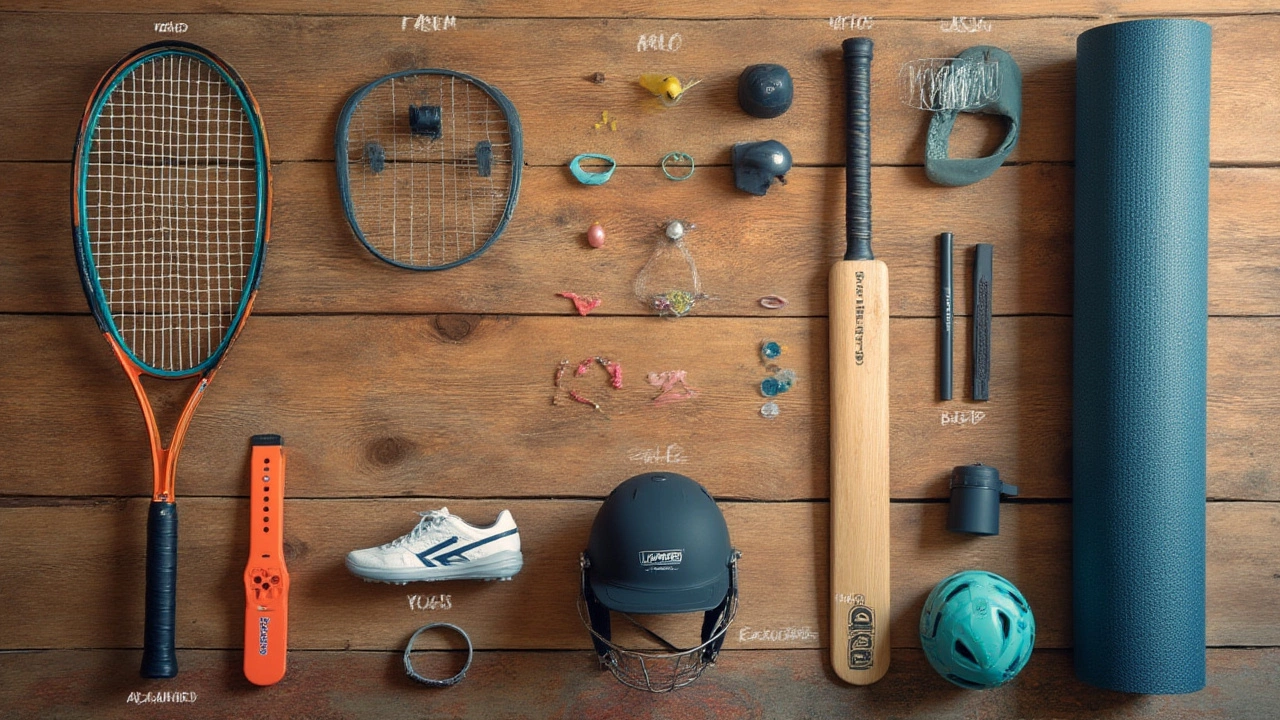Ever walk into a giant sporting goods store and wonder why there are so many different words for the stuff you see? Is it gear, equipment, apparel, or just plain sports products? The world of sports has built this mountain of terms, but they actually mean very different things once you start digging.
There’s a nickname for practically every piece of kit out there. The word you use can even change based on whether you’re talking shop with a coach, browsing a sports e-commerce site, or gossiping with your gym buddy. So, what’s the actual name for a “sports product”? That rabbit hole is deeper than you think.
What Are Sports Products?
Think of "sports products" as the big, catch-all phrase that covers almost everything used in sports and fitness. It's handy for shopping or when you're describing a packed sports shed, but it's not very specific if you want to know exactly what goes into a boxing match versus a morning run.
Sneakers, soccer balls, bikes, fitness trackers, and basketball hoops all get shoved under this umbrella. Even stuff like energy gels, mouthguards, and hydration belts count—they might look small, but they're a vital piece of the sporting puzzle. The secret: the term sports products covers both the stuff you need to play the sport, and the extras that make things more comfortable, fun, or even stylish.
If you check out a big retailer's website, you’ll see "Sports Equipment" and "Sporting Goods"—those are popular official terms. In fact, the U.S. Bureau of Economic Analysis lumps this whole market into "Sporting Goods, Hobby, Musical Instrument, and Book Stores" for their data sets. That category pulled in roughly $57 billion in the U.S. in 2023, up 7% from 2022.
But not every sports product is physical. The ticket for live matches, streaming services for events, and even augmented reality coaching apps all show up in the modern mix. So the world of sports products got bigger, fast—and your gear collection probably did too.
Gear vs Equipment: Clearing Up the Confusion
Let’s get real: most people (even lifelong athletes) use “gear” and “equipment” like they mean the exact same thing. But does a tennis racquet belong in your gear bag or your equipment locker? Here’s the scoop: equipment usually means the essential objects needed for a given sport—think footballs, bats, helmets, or nets. It’s the basic stuff that gets a game going, and leagues often standardize equipment for safety and fairness.
Gear means something a little broader. It’s all your personal stuff—like a lifting belt, wrist wraps, sweatbands, or a fitness GPS watch. Your gear expresses your personal style and sometimes gives you a little edge. That high-tech compression shirt or sweat-proof earbuds? That’s gear. You might swap gear based on mood or the weather, but your equipment usually stays the same.
- Equipment: items essential for the correct and safe play of a sport (e.g., ball, racket, helmet, goal post)
- Gear: optional and personal-use items that help, protect, or enhance performance (e.g., gloves, clothing, hydration packs, headphones)
The lines blur sometimes—especially in new sports or as technology changes the game. For example, cycling shoes were just gear for years, but with the rise of clipless pedals, they’re pretty essential, too. So, the best way to get it right? Ask what’s needed to start, and what’s there for that extra mile.

Apparel, Footwear, and Accessories: Breaking Down the Details
This is where things get personal and can show off your taste—or your technical know-how. Sportswear used to mean a pair of ratty gym shorts and a faded tee, but these days? There’s a whole industry of performance-mad fabrics and athlete-designed cuts.
Here’s how it splits up:
- Apparel: The clothing you wear for training or competition—jerseys, shorts, leggings, sports bras, sweat-wicking tops, base layers. Brands fight to engineer lighter, more breathable, and better-fitting pieces using things like proprietary “climate cool” polyester blends or even recycled plastics. In 2024, this segment hit $212 billion globally, fueled by the “athleisure” trend (think: gymwear in cafes and boardrooms.)
- Footwear: Serious science goes into making the perfect shoe for each sport—so much so, that the right pair can boost your sprint time, minimize injury, or just make long games bearable. There are now hyper-specific categories: “motion control” running shoes, “grip-enhanced” basketball sneakers, and slide-on pool sandals. Nike, Adidas, and ASICS spent more on R&D in sneaker tech last year than the entire GDP of some small countries.
- Accessories: This is where creativity and comfort come together. Accessories include water bottles, wristbands, mouthguards, smartwatches, tape, headbands, backpacks, even yoga mats. Want proof of how deep this goes? The global sports accessories market broke $38 billion in 2023—all from the little “extras” you pack in your gym bag.
More athletes are geeking out over data, too—heart rate monitors, GPS trackers, and power meters are flying off shelves. Personalization is huge: laser-engraved mouth guards, custom-fitted insoles, and even NFT-linked smart jerseys for fans and pros alike.
"Sports equipment often becomes a kind of personal extension, not just a tool. The way you choose, care for, and use your equipment can say as much about you as your performance does." – Dr. Jane Hu, Professor of Sports Physiology, University of Manchester
Here are some common terms and how brands use them in their catalogs:
| Term | What It Means | Examples |
|---|---|---|
| Equipment | Essential for play | Ball, net, racket, helmet |
| Gear | Personal/performance add-ons | Shin guards, gloves, fitness watch |
| Apparel | Clothing made for sport | Shorts, t-shirts, jerseys |
| Footwear | Sport-specific shoes | Running shoes, cleats, spikes |
| Accessories | Non-essential extras | Hats, water bottles, bags |
What’s Driving Naming Trends? A Look at Sports Commerce
Brands don’t just make up fancy names for fun—it usually reflects what athletes and fans actually want. Search for “sports goods” on Google, and you’ll most likely end up in a section labeled “equipment.” Visit Nike, Under Armour, or Decathlon, you’ll see sharp divisions: equipment, apparel, footwear, accessories. Why? Because clear categories help buyers find exactly what they need without getting lost, and it helps brands push the hottest products to the front.
Here’s what’s really pushing these naming trends:
- Specialization: Sports are getting more specialized, and so is the stuff you need. Modern tennis racquets come in over a dozen weight/balance combinations. Soccer boots are made with different stud placements for each kind of grass.
- Tech Innovation: As gear gets more high-tech, naming helps you know what’s high-performance. For instance, “smart” or “connected” gear only emerged in the 2010s and now dominates the wearables section.
- Fashion & Lifestyle: Athleisure means that plenty of people are wearing “sports apparel” that never sees a gym. But the same labels get reused, which can be confusing. Did you know nearly 52% of yoga mats sold in 2024 were bought by people who had never attended a yoga class?
- Globalization: Product names can shift based on region—Americans say “cleats” but Brits usually say “football boots.” The language in catalogues changes depending on where the brand wants to sell.
Need to shop smarter? Try searching with the exact term for your sport (“running hydration pack” or “rugby scrum cap”) rather than just “sports gear.” This makes finding the right item easier and helps avoid mismatches in size, spec, or even legality if you’re competing under official rules.
Keep in mind, some products overlap categories. Compression sleeves might be listed as both apparel and gear. Certain balls (like for squash or table tennis) are equipment, but grips for rackets are usually seen as accessories. If it’s designed to change performance or comfort, brands will usually call it “gear,” and if it’s officially sanctioned, it’s called “equipment.”
Here are some tips for buying sports products with confidence:
- Check the official site of the league or competition for equipment regulations.
- Use the manufacturer’s sizing charts—for both apparel and shoes.
- Ask store experts or join sport-specific online forums for advice.
- Look for reviews from athletes with similar needs or body types.
The world of sports products is only going to get bigger and more complex. The next big thing is already here—smart gear that tracks your performance. Good luck making sense of tomorrow’s buzzwords, but at least now you know where to start.
